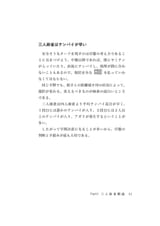Search Results
6/19/2025, 10:00:11 PM
>Tenpai is reached more quickly in sanma
>Keep in mind that keeping safer groups is an early game approach. In midgame and later opponents could already be tenpai and discarding a more dangerous group could already deal in. You'd want to get rid of the currently safer 89s group at that stage.
>Your opponents and their discards can change how you play a hand, even when you have the exact same tiles. This is one of the fun parts of mahjong.
>In sanma, the average number of turns to reach tenpai is lower. Often one player will reach tenpai on the first row, in the second row at least two players will be tenpai and someone wins before the second row ends.
>Because hands are so fast, early game decisionmaking is very important.
You know, I should probably just do one chapter per post (except in cases where multiple pages have important diagrams). That way the full context is more apparent and I can be annoyed less by the retarded post timer. I'll do that starting next chapter.
>Keep in mind that keeping safer groups is an early game approach. In midgame and later opponents could already be tenpai and discarding a more dangerous group could already deal in. You'd want to get rid of the currently safer 89s group at that stage.
>Your opponents and their discards can change how you play a hand, even when you have the exact same tiles. This is one of the fun parts of mahjong.
>In sanma, the average number of turns to reach tenpai is lower. Often one player will reach tenpai on the first row, in the second row at least two players will be tenpai and someone wins before the second row ends.
>Because hands are so fast, early game decisionmaking is very important.
You know, I should probably just do one chapter per post (except in cases where multiple pages have important diagrams). That way the full context is more apparent and I can be annoyed less by the retarded post timer. I'll do that starting next chapter.
Page 1
